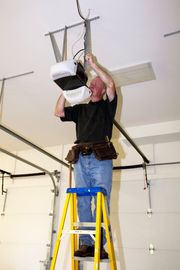How Do Garage Door Safety Sensors Work?

The garage door is a convenient entryway to your home, providing you with the ease of pulling in, parking your car, and walking inside. However, whether you have small kids or curious animals, having a garage without sensors can cause a host of problems. If you’d like to know how you can benefit from a garage sensor, consider how the mechanism works and what safety advantages it provides.
How Does a Garage Safety Sensor Work?
A garage sensor is a preventive safety feature designed to protect both humans and animals from being hurt as the door shuts. Required by law during installation since 1993, sensors come in both mechanical and photoelectric forms.
 Mechanical sensors work by making the garage door reverse when physical contact is made with an object. Photoelectric sensors have become more common and use an infrared beam.
Mechanical sensors work by making the garage door reverse when physical contact is made with an object. Photoelectric sensors have become more common and use an infrared beam.
This beam is typically placed six inches above the ground, with two aligned sensors placed on either side of the door. An invisible trip is projected, causing the door to withdrawal if a leg, car tire, or small animal crosses it.
What Are the Advantages of Safety Sensors?
A garage sensor protects both your children and pets. Without a sensor, an automatic door will continue to close – even if it comes into contact with an object, person, or animal.
Additionally, sensors can also provide a layer of safety for your vehicle. If you accidentally try to park the car while the door is shutting, the sensor will stop the component from hitting the vehicle. You’ll be able to park safely and avoid any damage to both the garage door and your car.
If your garage sensor is no longer working, consult with the professionals at Pioneer Overhead Door, Inc, in Lincoln, NE. With more than 50 years of experience, this team has provided the services you need to ensure your garage door works optimally and safely. To learn more about the services they offer, visit them online or call (402) 476-6539.
About the Business
Have a question? Ask the experts!
Send your question

